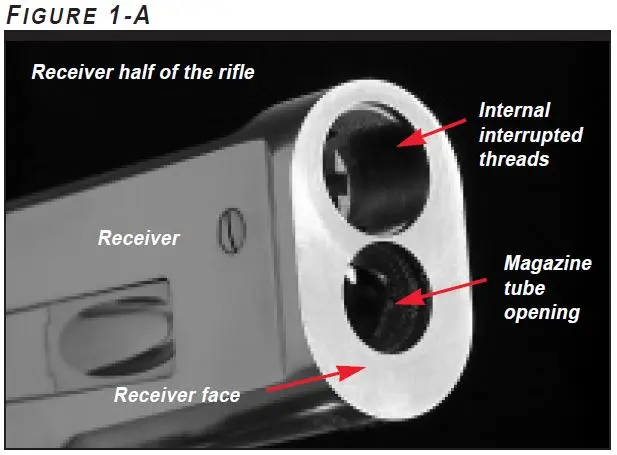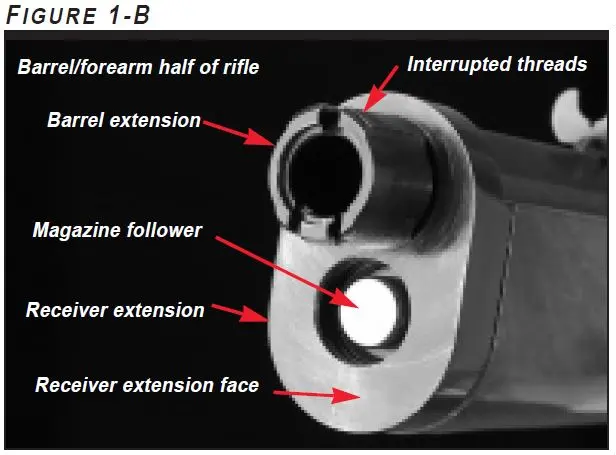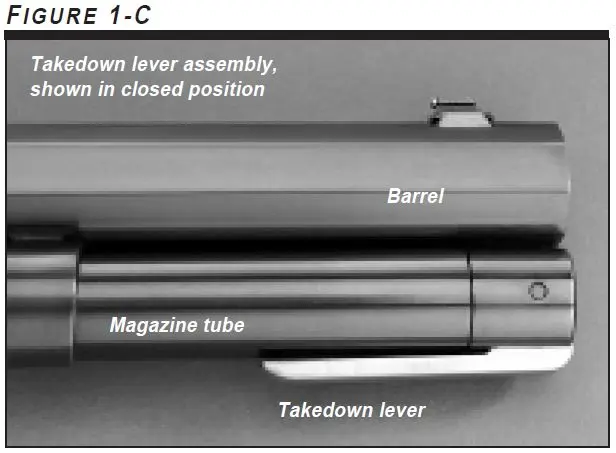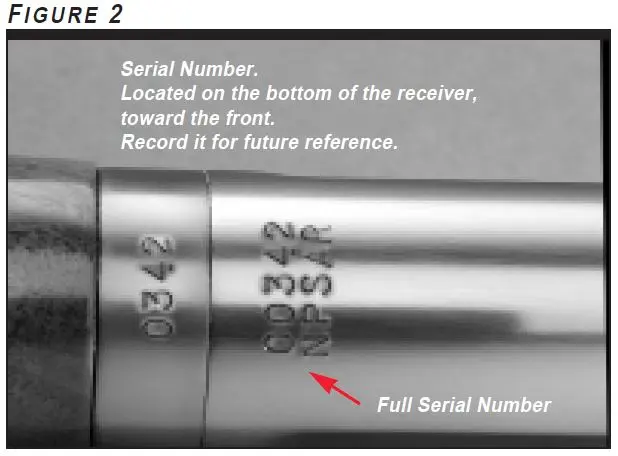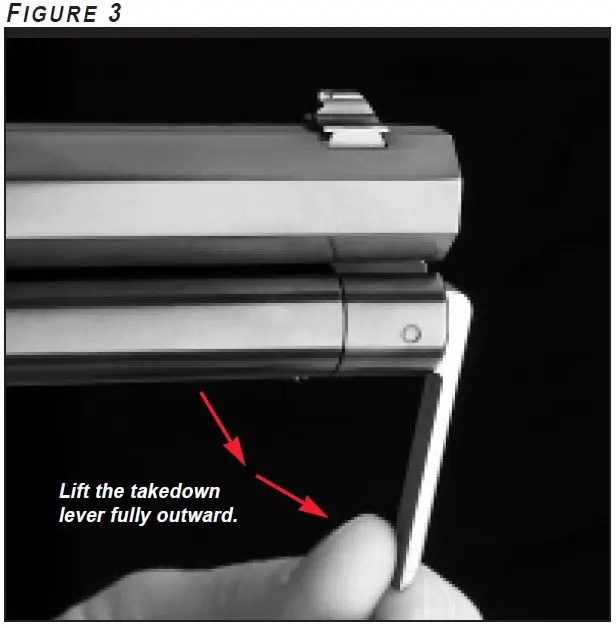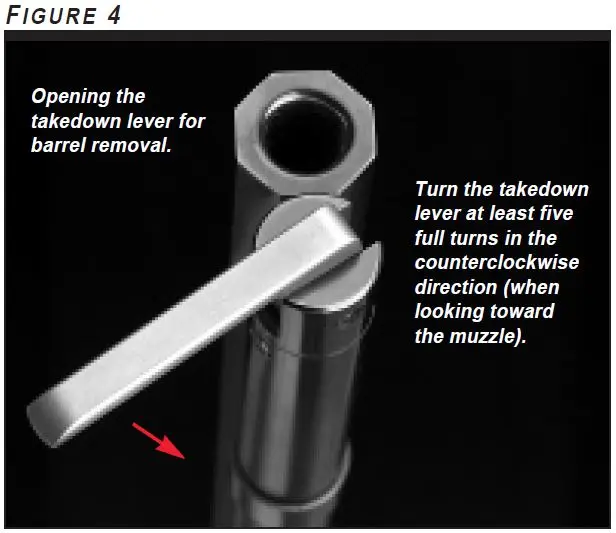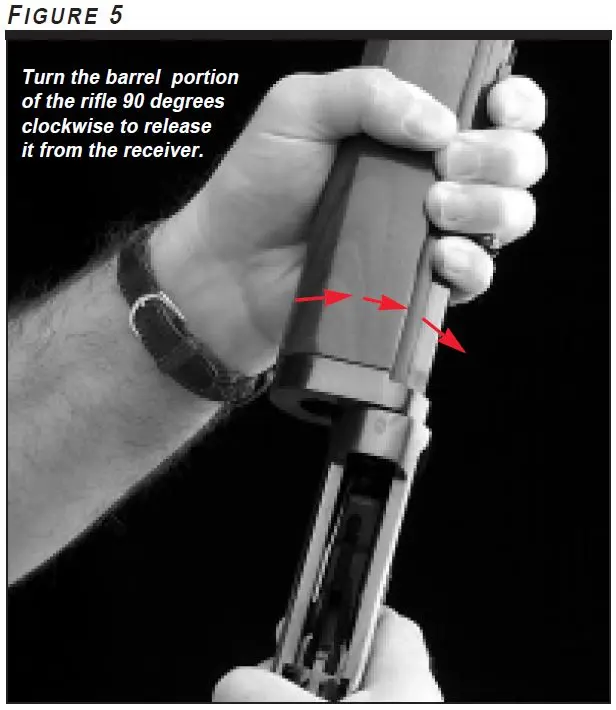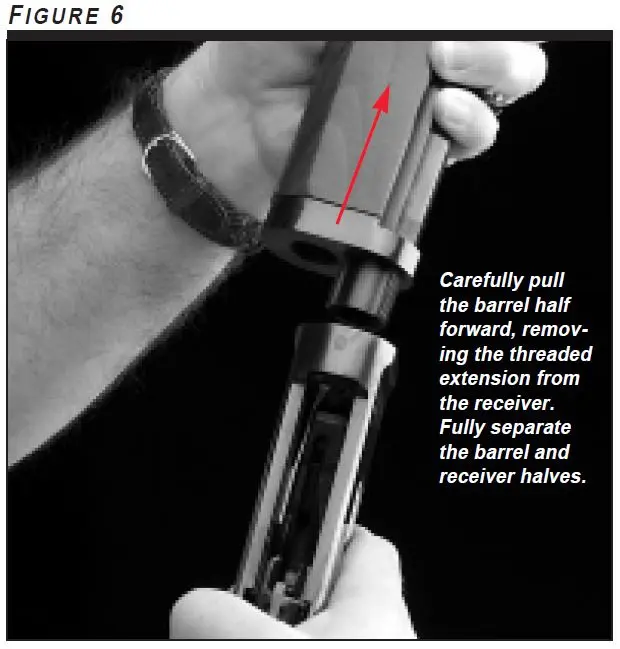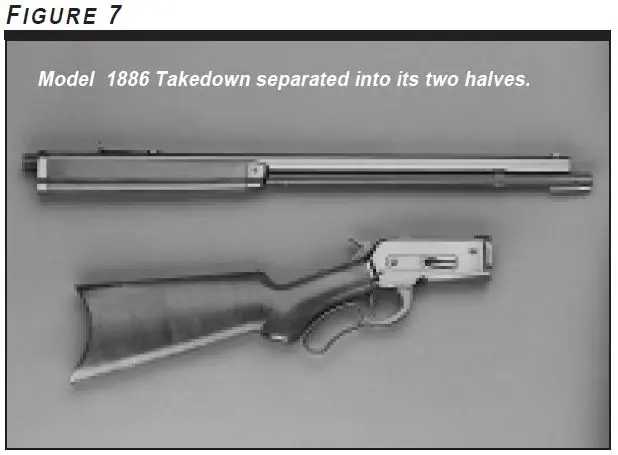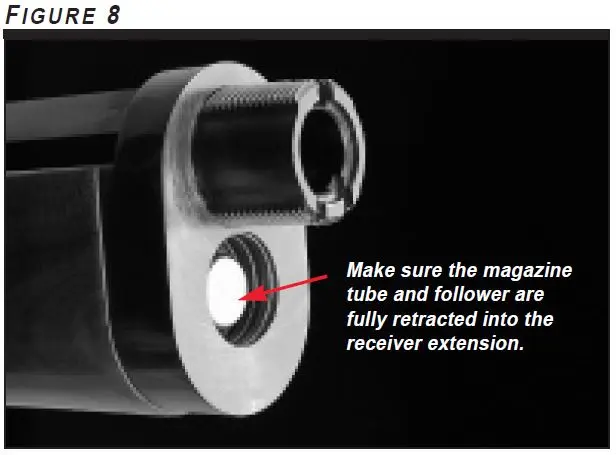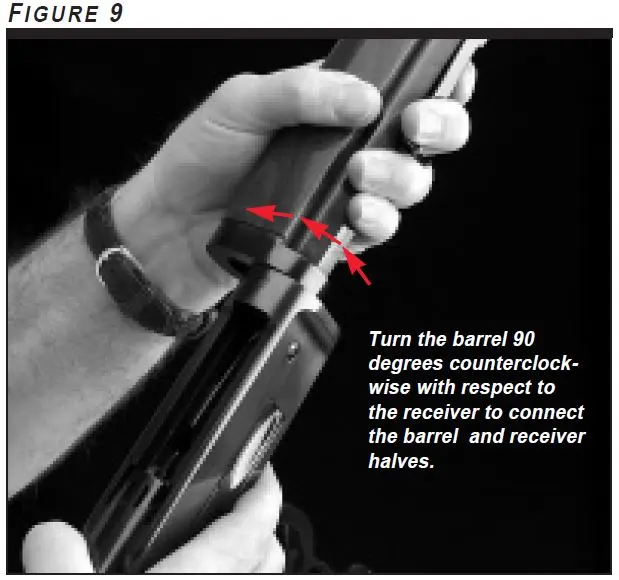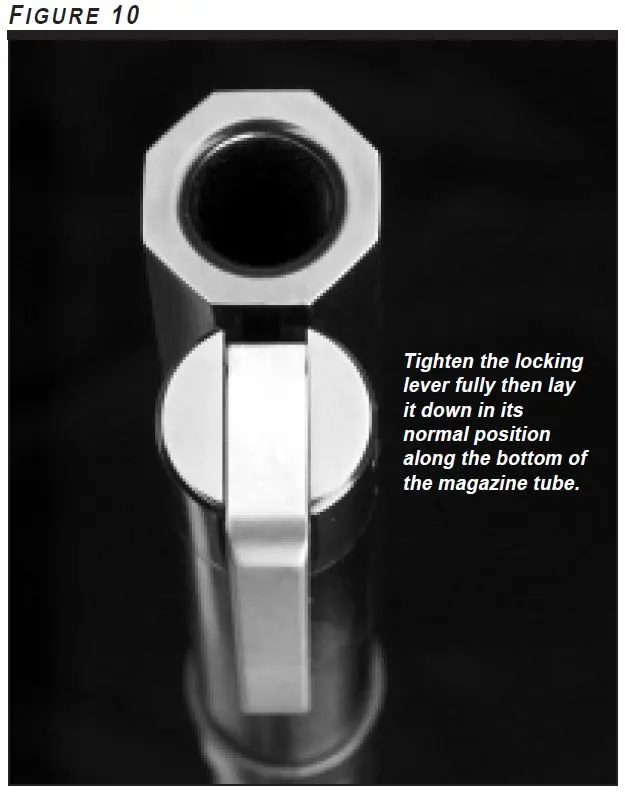Model 1886 Takedown Lever Action Rifle Supplement
Model 1886 Takedown Lever Action Rifle Supplement
Winchester is a registered trademark of Olin Corporation.
Important Supplementary Instructions for Winchester Model 1886 Takedown Lever Action Rifle.
These are special instructions for the Winchester Model 1886 Takedown version only. These instructions must be used in conjunction with the instructions in the full Model 1886 Owner’s Manual. If your manual is missing please contact U.S. Repeating Arms immediately to obtain a new manual free of charge. Phone numbers and addresses are contained inside this manual.
U.S. Repeating Arms Company, Inc.
344 Winchester Ave.
New Haven, CT, U.S.A. 06511-1970
Administrative Offices:
275 Winchester Ave.
Morgan, UT, U.S.A. 84050-9333
Please use the space below to record information about your new firearm.
Serial Number ___________________________________________________
Caliber _________________________________________________________
Model _________________________________________________________
Purchased From __________________________________________________
Date of Purchase __________________________________________________
Specifications within this owner’s manual are correct at the time of printing and subject to change without notice.
Special Warnings for the Take-Down Model 1886
Special Warnings for the Take-Down Model 1886
IT IS ESSENTIAL THAT THESE OPERATING INSTRUCTIONS AND THE INSTRUCTIONS /WARNINGS PROVIDED IN THE MODEL 1886 OWNER’S MANUAL BE THOROUGHLY STUDIED BEFORE USING THIS FIREARM TO ASSURE PROPER AND SAFE GUN HANDLING. FAILURE TO FOLLOW THESE INSTRUCTIONS OR FAILURE TO OBEY ANY SAFETY WARNING MAY RESULT IN INJURY TO YOURSELF OR OTHERS, OR CAUSE DAMAGE TO YOUR GUN.
IF YOUR MODEL 1886 OWNER’S MANUAL IS MISSING YOU MUST OBTAIN ONE FROM YOUR DEALER OR US BEFORE USING YOUR NEW RIFLE.
As a gun owner, you accept a set of demanding responsibilities. How seriously you take these responsibilities can be the difference between life and death. There is no excuse for careless or abusive handling of any firearm. At all times handle your rifle and any other firearm with intense respect for its power and potential danger.
PLEASE READ AND UNDERSTAND ALL OF THE CAUTIONS, PROPER HANDLING PROCEDURES AND INSTRUCTIONS OUTLINED IN THIS BOOKLET BEFORE USING YOUR NEW FIREARM.
THE BARREL HALF OF YOUR RIFLE IS DESIGNED AND MADE FOR ONLY THE RECEIVER IT WAS SHIPPED WITH. BARRELS AND RECEIVERS ARE NOT INTERCHANGEABLE. NEVER ATTEMPT TO USE THE BARREL FROM ONE MODEL 1886 TAKE-DOWN ON ANOTHER RIFLE.
DISCHARGING FIREARMS IN POORLY VENTILATED AREAS, CLEANING FIREARMS, OR HANDLING AMMUNITION MAY RESULT IN EXPOSURE TO LEAD AND OTHER SUBSTANCES KNOWN TO CAUSE BIRTH DEFECTS, REPRODUCTIVE HARM AND OTHER SERIOUS PHYSICAL INJURY. HAVE ADEQUATE VENTILATION AT ALL TIMES. WASH HANDS THOROUGHLY AFTER EXPOSURE.
General Description
General Description
Your new Model 1886 has unique features found only on the takedown model. The primary difference is the addition of a mechanism that allows you to separate the barrel/forearm half of the rifle from the receiver half of the rifle. The takedown design utilizes an interrupted thread system on the barrel extension and receiver, and a special mechanism on the end of the magazine tube which allows you to disengage the barrel from the receiver.
ALL OTHER GENERAL INSTRUCTIONS AND WARNINGS ARE THE SAME AS FOUND IN THE MODEL 1886 OWNER’S MANUAL. IF YOUR MANUAL IS MISSING PLEASE CONTACT US IMMEDIATELY FOR A FREE COPY — BEFORE ATTEMPTING TO USE YOUR NEW RIFLE.
YOU MUST REFER TO YOUR MODEL 1886 OWNER’S MANUAL FOR DETAILS ON THE SAFETY AND OTHER FEATURES FOUND ON YOUR NEW MODEL 1886.
Terminology and Descriptions
Terminology and Descriptions
Descriptions in this manual generally refer to the gun in the horizontal position — in the normal firing position. For example, the muzzle is forward or front; the butt stock is rearward or rear; the trigger is downward or underneath; the sight is upward or on top. For terminology related to the takedown feature of this rifle, refer to Figures 1A - C. Throughout this manual the “action” refers to the mechanism of this rifle which loads and secures the cartridge in the chamber.
The takedown system utilizes a threaded barrel extension with interrupted threads, which allows the barrel to be attached to the receiver with merely a 90° turn. The barrel is locked in place in the receiver with a special, retracting magazine tube design that is operated using a lever on the front end of the magazine tube.
Serial Number
Serial Number
The full serial number is located on the receiver half of the rifle, on the bottom of the receiver, toward the front (see Figure 2). The last four digits of the number portion of the serial number are also on the receiver extension just forward of where it mates with the receiver. Record the full serial number at the front of this book for future reference.
THE BARREL MUST ONLY BE USED WITH THE SAME RECEIVER IT WAS SOLD WITH. BARRELS ARE NOT INTERCHANGEABLE WITH ANY CURRENT OR OLDER MODEL 1886 TAKEDOWN RIFLE.
Takedown Procedure
Takedown Procedure
When your rifle is fully assembled use this procedure to take it down into its two parts.
COMPLETELY UNLOAD YOUR RIFLE BY REMOVING ALL CARTRIDGES FROM THE MAGAZINE, CHAMBER AND FEED AREAS AS EXPLAINED IN YOUR MODEL 1886 MANUAL. MAKE SURE YOUR RIFLE IS POINTED IN A SAFE DIRECTION. TAKING DOWN YOUR RIFLE WITH A CARTRIDGE IN THE MAGAZINE IS NOT ONLY DANGEROUS, IT WILL ALSO PREVENT DISASSEMBLY.
PLACE THE SAFETY IN THE “ON SAFE” POSITION. PLACE YOUR RIFLE OVER A PADDED SURFACE ON A TABLE, WORK BENCH OR OTHER SUITABLE LOCATION TO PREVENT DROPPING IT DURING DISASSEMBLY.
1. Open the bolt completely by working the finger lever downward and fully forward as explained in your Model 1886 owner’s manual. The barrel will not separate from the receiver unless the action is opened. Failure to do this can damage bolt components if you attempt to remove the barrel by force with the bolt is closed.
2. Open the takedown lever on the end of the magazine tube by lifting it fully outward, away from the magazine (see Figure 3).
3. Looking from the muzzle end of the rifle, rotate the lever counterclockwise at least five full turns (see Figure 4).
4. Hold your rifle in shooting position (one hand hold the receiver of the rifle and the other holding the fore-arm). Grasp the barrel half firmly with one hand and the receiver firmly with the other.
5. With the rifle oriented with you looking from the receiver toward the barrel, turn the barrel assembly clockwise 90 degrees (see Figure 5). This unlocks the barrel threads from the matching threads in the receiver.
6. Pull the barrel forward, removing the threaded barrel extension from the receiver (see Figure 6).
WARNING: IF THE BARREL SECTION WILL NOT TURN WITH RESPECT TO THE RECEIVER DO NOT APPLY EXTRA FORCE UNTIL YOU CHECK AGAIN TO MAKE SURE YOU HAVE FIRST OPENED THE ACTION AND THAT THE TAKEDOWN LEVER ON THE END OF THE MAGAZINE HAS BEEN SUFFICIENTLY TURNED TO DISENGAGE THE MAGAZINE TUBE AND FOLLOWER FROM THE RECEIVER. APPLYING UNDUE FORCE WITH THE BOLT STILL LOCKED IN THE ACTION COULD DAMAGE THE ACTION.
(If the two halves will not turn with respect to each other as explained, also loosen the release lever another turn or two until the halves will turn and separate. The magazine tube and follower must be turned into the receiver extension sufficiently to clear the front surface of the receiver.)
7. The barrel is now removed from the receiver and you are holding the two halves of your rifle. Your rifle is now fully taken down (refer to Figure 7).
8. To case or store your rifle in the two halves first return the takedown lever to its normal position, flush with the bottom of the magazine, centered on the bottom of the magazine tube. Then close the the bolt by working the finger lever rearward then upward.
YOU MUST AVOID INADVERTENTLY ATTEMPTING TO TAKEDOWN THE RIFLE WITH THE ACTION CLOSED. THIS CAN CAUSE DAMAGE TO THE BOLT OR OTHER COMPONENTS.
Re-Assembly Procedure
Re-Assembly Procedure
If your rifle is taken down into its two component parts follow these instructions for re-assembly and for preparing your rifle for use.
MAKE SURE YOUR RIFLE IS COMPLETELY UNLOADED. ASSURE THAT ALL CARTRIDGES ARE REMOVED FROM THE MAGAZINE, CHAMBER AND FEED AREAS AS EXPLAINED IN YOUR MODEL 1886 MANUAL. MAKE SURE YOUR RIFLE’S MUZZLE IS POINTED IN A SAFE DIRECTION.
PLACE THE SAFETY IN THE “ON SAFE” POSITION.
1. Open the action completely by lowering the finger lever and positioning it fully forward as explained in your Model 1886 owner’s manual.
2. Pull the takedown lever fully downward (refer back to Figure 3). Double check to make sure the magazine tube and follower are not protruding from the receiver extension (see Figure 8). If the magazine tube and follower protrude, retract them completely as explained under Step 3 of the instructions under “Takedown Procedure.”
3. Hold the receiver half of the rifle in one hand and the barrel half in the other.
4. Position the receiver half in normal shooting position (top of the receiver upward) and position the barrel half rotated slightly until the bottom of the forearm is on the left side, angled at approximately 90 degrees.
5. Insert the threaded barrel extension fully into the receiver. The interrupted threads on both the barrel extension and in the receiver allow you to insert the barrel into the receiver.
6. With the barrel extension inserted, turn the barrel counterclockwise 90° to tighten the connection (see Figure 9). Very little force should be required to turn the barrel assembly into its proper position.
WARNING: IF THE BARREL SECTION WILL NOT TURN WITH RESPECT TO THE RECEIVER DO NOT APPLY EXTRA FORCE UNTIL YOU CHECK AGAIN TO MAKE SURE YOU HAVE FIRST OPENED THE ACTION FULLY AND THAT THE MAGAZINE TUBE AND FOLLOWER ARE FULLY RETRACTED. APPLYING FORCE WITH THE BOLT STILL CLOSED IN THE ACTION COULD DAMAGE THE ACTION.
ALSO MAKE CERTAIN THE MAGAZINE WAS FULLY UNLOADED. A CARTRIDGE IN THE MAGAZINE WHEN TAKING DOWN YOUR RIFLE IS NOT ONLY DANGEROUS, IT WILL ALSO PREVENT DISASSEMBLY.
If it still will not turn, check to make sure there is no foreign matter (dirt, grit, etc.) between the faces on the receiver and barrel halves. Wipe clean and lightly oil. Retract the magazine tube and follower one or two more turns. Try again.
7. With the two halves properly in place, tighten the locking lever fully by tuning it fully closed. By doing this you are turning the magazine tube back into the match-ing recess in the receiver. Visually, the turn direction is counterclockwise when viewed from the receiver, or clockwise when viewed looking down toward the muzzle.
8. Be sure to fully tighten the locking lever. Fold the locking lever over until it lays along the bottom of the magazine tube (see Figure 10). The locking lever may be slightly off-center with respect to the bottom of the magazine tube when fully tightened. This is not a prob-lem. Simply rotate it into alignment. Your rifle is now fully reassembled.
Ordering Parts
Ordering Parts
To order parts, please write our parts department and furnish the following: your name, address, and telephone number. Also specify the model and serial number of your gun. When we receive your request, we will send an order form and a parts breakdown with prices.
Write to:
Parts Department
U.S. Repeating Arms Company, Inc.
344 Winchester Ave.
New Haven, CT, U.S.A. 06511-1970
CAUTION: PARTS ARE MADE FOR WINCHESTER BRAND FIREARMS MANUFACTURED BY OR FOR U.S. REPEATING ARMS COMPANY, INC., AND SHOULD NOT BE USED IN OTHER GUNS EVEN THOUGH MODELS MAY BE SIMILAR. IMPROPERLY FITTED PARTS MAY BE DANGEROUS.
Ordering Parts
Ordering Parts
To order parts, please write our parts department and furnish the following: your name, address, and telephone number. Also specify the model and serial number of your Winchester firearm. When we receive your request, we will send an order form and a parts breakdown with prices.
Write to:
Parts Department
U.S. Repeating Arms Company, Inc.
275 Winchester Ave.
New Haven, CT, U.S.A. 06511-1970
CAUTION: PARTS ARE MADE FOR WINCHESTER BRAND FIREARMS MANUFACTURED BY OR FOR U.S. REPEATING ARMS COMPANY, INC., AND SHOULD NOT BE USED IN OTHER GUNS EVEN THOUGH MODELS MAY BE SIMILAR. IMPROPERLY FITTED PARTS MAY BE DANGEROUS.
Service or Repair
Service or Repair
If your Winchester firearm should ever need repair or service, please utilize one of the worldwide network of U.S. Repeating Arms Company Authorized Repair Centers for Winchester firearms. A list of ARCs is packaged with your new gun. If you need to obtain a new list of ARCs call us at:
1-203-789-5000
Questions
Questions
If you have other questions about Winchester rifles and shotguns, call or write our Customer Service Department:
Customer Service
U.S. Repeating Arms Company, Inc.
275 Winchester Avenue
Morgan, UT 84050-9333
Phone: (800) 945-5237
customersupport@winchesterguns.com
WINCHESTER-GUNS.COM
WINCHESTER-GUNS.COM
U.S. Repeating Arms Company offers an information resource for you on the world wide web.
- List of Authorized Repair Centers.
- Customer Service information.
- Answers to many technical and historical questions.
- Links to helpful sites.
Go to: www.winchester-guns.com
WARNING: YOU ARE RESPONSIBLE FOR FIREARMS SAFETY
WARNING: YOU ARE RESPONSIBLE FOR FIREARMS SAFETY
As a gun owner, you accept a set of demanding responsibilities. How seriously you take these responsibilities can mean the difference between life and death. Failure to follow any of these instructions can cause extensive damage to your gun and/or possible serious injury or death to yourself and others. There is no excuse for careless or abusive handling of any firearm. At all times handle any firearm with intense respect for its power and potential danger.
PLEASE READ AND UNDERSTAND ALL OF THE CAUTIONS, PROPER HANDLING PROCEDURES AND INSTRUCTIONS OUTLINED IN THE OWNER’S MANUAL BEFORE USING YOUR NEW FIREARM.
1 - ALWAYS KEEP THE MUZZLE OF YOUR FIREARM POINTED IN A SAFE DIRECTION EVEN THOUGH YOU ARE CERTAIN IT IS UNLOADED. Never point any firearm at anything you do not intend to shoot. Be extremely alert and aware of all persons and property within the range of your ammunition.
2 - NEVER RELY TOTALLY ON YOUR FIREARM'S MECHANICAL “SAFETY” DEVICE.
The word “safety” describes a firearm’s trigger block mechanism, sear block mechanism, hammer block mechanism, or firing pin block mechanism. Mechanical “safeties” are designed to place your firearm in a safer status, and no guarantee can be made that the firearm will not fire even if the “safety” is in the on safe position. Mechanical “safeties” merely aid safe gun handling and are no excuse for pointing your firearm’s muzzle in an unsafe direction. See “Operation of the Safety” section below for instructions on the operation of this firearm’s “safety.”
LIKE ANY MECHANICAL DEVICE, A "SAFETY" CAN SOMETIMES FAIL; IT CAN BE JARRED OR INADVERTENTLY MANIPULATED INTO AN UNSAFE CONDITION.
Mechanical "safeties" merely aid safe gun handling and are no excuse for pointing your rifle's muzzle in an unsafe direction.
While it is a good idea to "test" your rifle's mechanical "safeties" periodically for proper function, NEVER TEST IT WHILE YOUR RIFLE IS LOADED OR POINTED IN AN UNSAFE DIRECTION
Safe gun handling does not stop with your gun's mechanical "safety devices -- it starts there. Always treat your rifle with the respect due a loaded, ready-to-fire firearm.
3. WHENEVER YOU HANDLE A FIREARM, OR HAND IT TO SOMEONE, ALWAYS OPEN THE ACTION IMMEDIATELY, VISUALLY CHECK YOUR RIFLE'S CHAMBER, FEED MECHANISM AND MAGAZINE.
Make certain they do not inadvertently contain any ammunition. Always keep the chamber empty and "safety" in the "on safe" position unless shooting is imminent.
4. DO NOT TRANSPORT YOUR RIFLE LOADED, WHETHER IN A SCABBARD, GUN CASE, OR OTHER CONTAINER.
5. HUNTING FROM ELEVATED SURFACES SUCH AS TREE STANDS IS DANGEROUS, and may increase the risk of handling a firearm. The following rules should always be observed by you and those you hunt with: Always make certain that the stand being used is safe and stable. Always make certain that your firearm is unloaded when it is being taken up to and down from the stand. Always make certain that your firearm is not dropped from the stand, or dropped while it is being taken up to or down from the stand. Remember, a loaded firearm may discharge when dropped, even with the safety in the "on safe" position.
6. BEWARE OF BARREL OBSTRUCTIONS, for the safety of both your gun and yourself. Mud, snow, and an infinite variety of other obstructions may inadvertently lodge in a barrel bore. It takes only one small obstruction to cause dangerously increased pressures that can ruin (swell or rupture) the finest rifle barrels.
BEFORE CHECKING FOR A BARREL OBSTRUCTION, BE CERTAIN NO LIVE ROUND IS IN THE CHAMBER AND THAT THE MAGAZINE IS REMOVED AND FEED MECHANISMS ARE COMPLETELY EMPTY. PLACE THE "SAFETY" IN THE "ON SAFE" POSITION.
Look through the barrel to be sure it is clear of any obstruction. If an obstruction is seen, no matter how small it may be, clean the bore with a cleaning rod and patch as described in "Cleaning and Maintenance Suggestions." Before the first firing, clean the bore with a cleaning rod and patch, and wipe away any anti-rust compound in the action / chamber areas.
7. ALWAYS UNLOAD YOUR RIFLE WHEN NOT IN USE. REFER TO "UNLOADING THE RIFLE" FOR AN EXPLANATION OF HOW TO UNLOAD YOUR RIFLE PROPERLY.
As a safety precaution, it is preferable to disassemble your gun for storage. Store your gun and ammunition separately -- well beyond the reach of children. Take all safeguards to ensure your rifle does not become available to untrained, inexperienced or unwelcome hands.
8. USE THE PROPER AMMUNITION.
The barrel and action of this rifle have been made with substantial safety margins over the pressures developed by established American commercial loads. Nevertheless, Browning assumes no liability for incidents which occur through the use of cartridges of nonstandard dimensions which develop pressures in excess of commercially available ammunition with standards established by the Sporting Arms and Ammunitions Manufacturers' Institute (SAAMI).
BE ALERT TO THE SIGNS OF AMMUNITION MALFUNCTION.
If you detect an off sound or light recoil when a cartridge s fired, DO NOT LOAD ANOTHER CARTRIDGE INTO THE CHAMBER. Open the action and remove all cartridges from the magazine, chamber and action areas. With the action open, glance down the barrel to make sure that an obstruction does not remain in the barrel. If there is an obstruction, completely clear the barrel before loading and firing again. Failure to follow these instructions can cause extensive damage to your gun and possible serious injury to yourself and others.
MAKE SURE OF ADEQUATE VENTILATION IN THE AREA THAT YOU DISCHARGE A FIREARM. WASH HANDS THOROUGHLY AFTER EXPOSURE TO AMMUNITION OR CLEANING A FIREARM.
Lead exposure can be obtained from discharging firearms in poorly ventilated areas, cleaning firearms or handling ammunition. Lead is a substance that has been known to cause birth defects, reproductive harm and other serious injury.
9. DO NOT SNAP THE FIRING PIN ON AN EMPTY CHAMBER -- THE CHAMBER MAY NOT BE EMPTY!
Treat every gun with the respect due a loaded gun, even though you are certain the gun is unloaded.
10. KEEP FINGERS AWAY FROM THE TRIGGER WHILE UNLOADING, LOADING, UNTIL YOU ARE READY TO SHOOT.
11. BE SURE OF YOUR TARGET AND BACKSTOP.
Particularly during low light periods. Know the range of your ammunition. Never shoot at water or hard object.
12. ALWAYS UNLOAD YOUR RIFLE'S CHAMBER BEFORE CROSSING A FENCE, CLIMBING A TREE, JUMPING A DITCH OR NEGOTIATING OTHER OBSTACLES.
Refer to "Unloading The Rifle" for instructions on the unloading of your rifle. Never place your loaded rifle on or against a fence, tree, car or other similar object.
13. WEAR EYE AND EAR PROTECTION WHEN SHOOTING.
Unprotected, repeated exposure to gunfire can cause hearing damage. Wear ear protectors (shooting ear plugs or muffs) to guard against such damage. Wear shooting glasses to protect your eyes from flying particles. Allow proper distance (eye relief) between the scope and your eye when firing a scoped rifle or shotgun. Always keep a safe distance between the muzzle of your firearm and any persons nearby, as muzzle blast, debris and ejecting shells could inflict serious injury. Also, wear eye protection when disassembling and cleaning your shotgun to prevent the possibility of springs, spring-tensioned parts, solvent or other agents from contacting your eyes.
14. DROPPING A LOADED GUN CAN CAUSE AN ACCIDENTAL DISCHARGE even with the "safety" in the "on safe" position. Be extremely careful while hunting or during any shooting activity, to avoid dropping any firearm.
15. IF YOUR RIFLE FAILS TO FIRE, KEEP THE MUZZLE POINTED IN A SAFE DIRECTION. Hold this position for a minimum of 30 seconds. Carefully open the action and remove the cartridge. If the primer is indented, the cartridge should be disposed of in a way that cannot cause harm. If the primer is not indented, your firearm should be examined by a qualified gunsmith and the cause of the malfunction should be corrected before further use.
16. BE DEFENSIVE AND ON GUARD AGAINST UNSAFE GUN HANDLING AROUND YOU AND OTHERS.
Don't be timid when it comes to gun safety. If you observe other shooters violating any of these safety precautions, politely suggest safer handling practices.
17. BE CERTAIN YOUR RIFLE IS UNLOADED BEFORE CLEANING. Because so many gun accidents occur when a firearm is being cleaned, special and extreme care should be taken to be sure your gun is unloaded before disassembly, cleaning and reassembly. Keep ammunition away from the cleaning location. Never test the mechanical function of any firearm with live ammunition.
18. TEACH AND SUPERVISE FIREARMS SAFETY TO ALL MEMBERS OF YOUR FAMILY --ESPECIALLY TO CHILDREN AND NONSHOOTERS.
Closely supervise newcomers to the shooting sports. Encourage enrolling in hunting/shooting safety courses.
19. NEVER DRINK ALCOHOLIC BEVERAGES OR TAKE ANY TYPE OF DRUGS BEFORE OR DURING SHOOTING.
Your vision and judgment could be dangerously impaired, making your gun handling unsafe to you and to others.
20. READ AND HEED ALL WARNINGS in this instruction book, on ammunition boxes and with all accessories that you install on your firearm. It is your responsibility to secure the most up-to-date information on the safe handling procedures of your Browning gun. Browning assumes no liability for incidents which occur when unsafe or improper gun accessories or ammunition combinations are used.
21. PERIODIC MAINTENANCE -- AVOID UNAUTHORIZED SERVICING.
Your rifle is a mechanical device which will not last forever, and as such, is subject to wear and requires periodic inspection, adjustment and service. Browning firearms should be serviced by a Browning Recommended Service Center or by Browning's service facility in Arnold, Missouri. Browning cannot assume any responsibility for injuries suffered or caused by unauthorized servicing, alterations or modifications of Browning firearms.
22. BROWNING RESERVES THE RIGHT TO REFUSE SERVICE ON FIREARMS THAT HAVE BEEN ALTERED, ADDED TO OR SUBSTANTIALLY CHANGED.
Removal of metal from barrel(s), or modification of the firing mechanism and/or operating parts may lead to Browning's refusal of service on such firearms. Browning will charge the owner parts and labor to return the firearm to original Browning specifications.
DO NOT, UNDER ANY CIRCUMSTANCES, ALTER THE TRIGGER, SAFETY OR PARTS OF THE FIRING MECHANISM OF THIS OR ANY OTHER FIREARM. FAILURE TO OBEY THIS WARNING MAY RESULT IN INJURY OR DEATH TO YOURSELF OR OTHERS.




